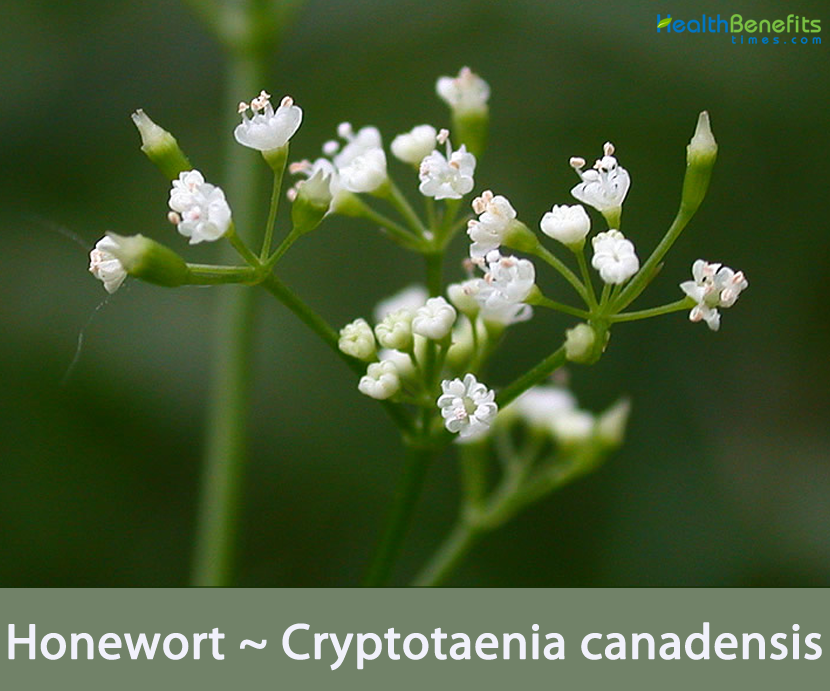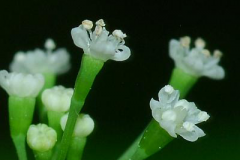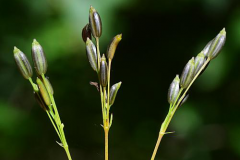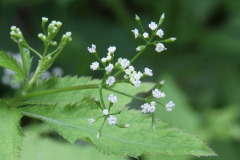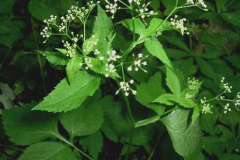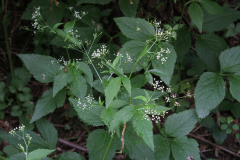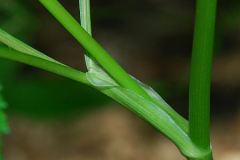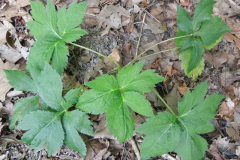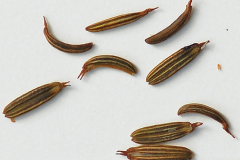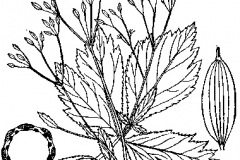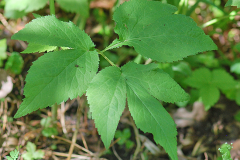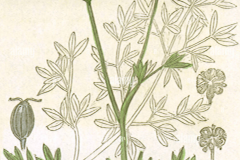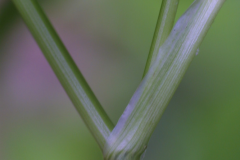| Honewort Quick Facts | |
|---|---|
| Name: | Honewort |
| Scientific Name: | Cryptotaenia canadensis |
| Origin | Eastern United States and eastern Canada |
| Colors | Green at first, turning dark brown with greenish-yellow ribs at maturity. |
| Shapes | 2-chambered seedcase (schizocarp). It is smooth, hairless, narrowly oblong-elliptic, and ⅛″ to ¼″ long. It is more than twice as long as wide |
| Taste | Crisp, celery-like taste (Leaves) |
| Name | Honewort |
|---|---|
| Scientific Name | Cryptotaenia canadensis |
| Native | Eastern United States and eastern Canada |
| Common Names | Honewort, wild chervil, umbel weed, Canadian honewort, White chervil, Canada honewort, Japanese parsley |
| Name in Other Languages | Afrikaans: Honewort Albanian: Honewort Amharic: Adīsi (አዲስ) Arabic: Alsharaf (الشرف) Armenian: Honewort Azerbaijani: Dəbdəbəli Bengali: Honewort Bulgarian: Honewort Burmese: Kyaayyjuupar (ကျေးဇူးပါ) Chinese: Honewort Croatian: Honewort Czech: Zimolez Danish: Honewort Dutch: Honewort English: Honewort, Canadian honewort, White chervil, Wild chervil, Canada honewort, Japanese parsley, umbelweed, Esperanto: Honewort Estonian: Kibuvits Filipino: Papuri Finnish: Honewort, Kanadanyrttiputki French: Miellée, Cryptoténie du Canada Georgian: Honewort–wôrt,ˈhōnˌwərt German: Honewort, kanadische Rispendolde Greek: Timí (τιμή) Gujarati: Honewort Hausa: Mannewa Hebrew: Honewort Hindi: Honewort Hungarian: Honewort Icelandic: Honewort Indonesian: Honewort Irish: Féithleann Italian: Honewort Japanese: Honewort Javanese: Ngaturake Kannada: Hanivarṭ (ಹನಿವರ್ಟ್) Kazakh: Qurmettew (құрметтеу) Korean: Honewort Kurdish: Honewort Lao: Bon chodheu (ບ່ອນຈອດເຮືອ) Latin: Honewort Latvian: Sausserdis Lithuanian: Sausmedis Macedonian: Honewort Malagasy: Honewort Malay: Penghargaan Malayalam: Hēāṇvēārṭṭ (ഹോൺവോർട്ട്) Maltese: Honewort Marathi: Honewort Mongolian: Khongor (хонгор) Nepali: Honewort Norwegian: Honewort Oriya: ହୋନୱର୍ଟ | Pashto: Honewort Persian: افتخار Polish: Honewort Portuguese: Honewort, Criptotenia Punjabi: Honewort Romanian: Honewort Russian: Honewort, kriptoteniya kanadskaya (криптотения канадская), skrytnitsa kanadskaya (скрытница канадская) Serbian: Honevort (хоневорт) Sindhi: اعزازي مڃيو Sinhala: Honewort Slovenian: Honewort Spanish: Honewort Sudanese: Honewort Swedish: Honewort, Kanadapersilja Tajik: ʙovafo (бовафо) Tamil: Honewort Telugu: Honewort Thai: Honewort Turkish: Honewort Ukrainian: Honewort Urdu: Honewort Uzbek: Samimiyat Vietnamese: Chúc mừng Welsh: Gwenith yr hydd Zulu: Honewort |
| Plant Growth Habit | Tuberous-rooted herbaceous perennial |
| Growing Climates | Rich woods, thickets, woodland ravines, riverbanks, deciduous and mixed forest, woodland margins, stream banks, edges of shady seeps, wooded areas along springs and streams, wooded bluffs, fence rows and shady edges of yards |
| Soil | Prefers medium to light shade, moist to mesic conditions, and rich, loamy soil with ample organic matter. It also often grows in silty soils. It tolerates waterlogged soils and temporary flooding |
| Plant Size | 1-3 feet tall |
| Root | Taproot system. Instead of growing clusters of long, fibrous roots, a honewort plant has one dominant root from which smaller, secondary roots (rootlets) grow |
| Stem | Erect, branched above the middle, light green, and hairless. They are slender, less than 5 ⁄16 inches thick |
| Leaf | Leaves are alternate and are divided into 3 leaflets. The terminal leaflet is symmetrical. The two lateral leaflets are asymmetrical, with the lower half (away from the terminal leaflet) usually distinctly wider than the upper half |
| Flowering season | June to July |
| Flower | Flowers have 0 to 5 sepals, 5 petals, 5 stamens, and 2 styles. The ovary is hairless. If present, the sepals are reduced in size to minute teeth. The petals are white, inversely egg-shaped, and rounded or abruptly pointed at the tip |
| Pollinators |
|
| Fruit Shape & Size | 2-chambered seedcase (schizocarp). It is smooth, hairless, narrowly oblong-elliptic, and ⅛ to ¼ inches long. It is more than twice as long as wide |
| Fruit Color | Green at first, turning dark brown with greenish-yellow ribs at maturity. |
| Taste | Crisp, celery-like taste |
| Plant Parts Used |
|
| Lifespan | Three or more years |
| Season | Late August and early September |
Plant Description
Honewort is a tuberous-rooted herbaceous perennial plant that normally grows about 1-3 feet tall. The plant is found growing in rich woods, thickets, woodland ravines, riverbanks, deciduous and mixed forest, woodland margins, stream banks, edges of shady seeps, wooded areas along springs and streams, wooded bluffs, fence rows and shady edges of yards. The plant prefers medium to light shade, moist to mesic conditions, and rich, loamy soil with sufficient organic matter. It also often grows in silty soils and tolerates waterlogged soils and temporary flooding.
Root
Honewort has a taproot system. Instead of growing clusters of long, fibrous roots, a honewort plant has one dominant root from which smaller, secondary roots (rootlets) grow.The roots, like the visible parts of the plant, are edible. They have a taste comparable to parsnips. The roots never get overly bitter with age, but they do become tougher. Generally, younger plants are more popular than mature ones. Because there is one central root, the plant does not spread by rhizomes.
Stem
Honewort stems are green and smooth. They don’t have any hairs growing along them. The stems are light green and have one leaf per node. If you look closely at the lower half of the stem, you’ll see elongated membranous sheaths forming around the petioles. These sheaths make the area of the stem they cover cloudy or milky, while the rest of the stem is a vibrant green. Like leaves, the stems are edible and a popular parsley substitute.
Leaves
The leaves are alternate and are divided into 3 leaflets. The terminal leaflet is symmetrical. The two lateral leaflets are asymmetrical, with the lower half (away from the terminal leaflet) usually distinctly wider than the upper half. This causes the leaflets to appear somewhat swept forward. Lower leaves are on leaf stalks (petioles) that are up to 4 inches long. The petiole forms a sheath at the base that wraps around the stem. The sheath is not inflated. When flattened out it is less than ⅜ inches wide.
The leaflets are lance-shaped, elliptic, or egg-shaped, 1¼ to 6 inches long, and up to 2 inches wide. They are sometimes cut into two unevenly-sized lobes. They taper at the base to a winged leaflet stalk (petiolule) and taper at the tip to a sharp point. The upper and lower surfaces are hairless. The margins are toothed with coarse or fine, sharp, forward-pointing teeth. They are sometimes doubly toothed, the major teeth larger and forward-pointing. The lateral veins of the leaflet branch before reaching the margin, and the branches extend to the tips of the major teeth. The leaves become progressively smaller and shorter stalked as they ascend the stem. Upper leaves are stalk less.
Flowers
The inflorescence is a compound umbel at the end of the stem and each branch appearing in June to July. The umbels are round and 2 to 3 inches in diameter, and have 2 to 7 stalks (rays). The rays are ascending, hairless, and 3 ⁄16 to 2 inches long. They are unequal in length. They are sometimes subtended by a single leaf-like appendage (bract). When present, the bract is linear, sharply pointed, and shorter than the ray. Each ray terminates in a secondary umbel (umbellet).
Each umbellet has 2 to 10 stalked flowers. The stalks (raylets) are 1⁄16 to 13 ⁄16 inches long and are unequal in length. They are sometimes subtended by 1 to 3 bractlets. The bractlets, when present, are lance-shaped, up to ⅛ inches long, and shorter than the raylets. Each raylet terminates in a single tiny flower.
The flowers have 0 to 5 sepals, 5 petals, 5 stamens, and 2 styles. The ovary is hairless. If present, the sepals are reduced in size to minute teeth. The petals are white, inversely egg-shaped, and rounded or abruptly pointed at the tip. There are 5 stamens, widely spaced, with yellowish anthers; 2 styles; both styles and anthers exserted from the corolla throat. The ovary is of 2 carpels. Sepals are absent or reduced to small scales, leaving the green calyx short and tubular.
Fruit
Fertile flowers are followed by a 2-chambered seedcase (schizocarp). It is green at first, turning dark brown with greenish-yellow ribs at maturity. It is smooth, hairless, narrowly oblong-elliptic, and 4 to 7 mm long. It is more than twice as long as wide. It is slightly flattened laterally and tapers to a short, prolonged extension (beak) at the tip. When ripe, the fruit splits into 2 separate seedcases (mericarps), each with a single seed. Seeds need at least 60 days of moist stratification for germination. Each mericarp has 5 ribs. The ribs are not winged.
Culinary Uses
- Young leaves, stems and flowers can be consumed raw or cooked.
- It is used as a potherb or added to salads.
- Root can be consumed after cooking.
- Seeds are used as flavoring for cakes, breads and biscuits.
- Its young leaves and stems may be used as a seasoning like parsley or as a boiled green.
- The roots may be cooked and eaten like parsnips.
Other Facts
- It is harvested from the wild for local use as a food.
- It is an interesting plant for shady areas of the landscape, native plant gardens and woodland areas.
- Honewort flowers, while very small, provide nectar for pollinators.
- The flowers are not fragrant, nor do they have a strong taste.
References:
https://www.itis.gov/servlet/SingleRpt/SingleRpt?search_topic=TSN&search_value=29475#null
http://www.hear.org/pier/species/cryptotaenia_canadensis.htm
https://pfaf.org/user/Plant.aspx?LatinName=Cryptotaenia+canadensis
https://www.missouribotanicalgarden.org/PlantFinder/PlantFinderDetails.aspx?taxonid=300015&n=1
https://gd.eppo.int/taxon/CPBCA
https://gobotany.nativeplanttrust.org/species/cryptotaenia/canadensis/
http://www.theplantlist.org/tpl1.1/record/kew-2746570
https://en.wikipedia.org/wiki/Cryptotaenia_canadensis
https://plants.usda.gov/home/plantProfile?symbol=CRCA9
https://www.illinoiswildflowers.info/woodland/plants/honewort.htm
https://www.minnesotawildflowers.info/flower/canadian-honewort
http://temperate.theferns.info/plant/Cryptotaenia+canadensis


